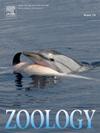Morphology of the circulatory system in Caobangia billeti Giard, 1893 (Annelida, Sabellidae)
IF 1.6
3区 生物学
Q2 ZOOLOGY
引用次数: 0
Abstract
Caobangia billeti is an aberrant shell-burrowing annelid with a phoronid-like body plan and U-shaped digestive tract, an anterior anus on the dorsal side near the head, and reduced metamerism. The segmental dissepiments in C. billeti are absent, but the circulatory system is complex and consists of numerous lacunae and vessels. We asked the question how this modified circulatory system compares to that of other Sabellida. To that end, we collected C. billeti from the type locality and for the first time provide a detailed morphological investigation of these worms using both electron (TEM) and light microscopy. Our data show that, despite the significant modification of the body plan, the circulatory system is generally similar to that of other Sabellida representatives. The central circulatory system includes dorsal and ventral vessels, circular segmental vessels, and the peri-intestinal sinus, while the peripheral system includes the vessels of the branchial crown, collar vessels and esophageal plexuses, and transseptal vessels. However, compared to other representatives of the order Sabellida this species possesses four paired lateroventral vessels instead of two, and extravasal rather than intravasal hematopoietic tissue. The abdomen of C. billeti has lost all internal metameric structures, except segmental vessels, the number of which coincides with the number of uncinial tori. The direction of blood flow was reconstructed using vital and morphological observations. There are no specialized propulsatory organs, but all vessels pulsate, except for the branchial vessels, which are passively filled with blood. In the circulatory system, the direction of blood flow can be reversed (from the head to the back of the body inside the dorsal vessel and vice versa ventrally), which has not previously been described for other Sabellida.
1893年曹班贾(Caobangia billeti Giard)循环系统的形态学研究(环节动物,Sabellidae)
草板甲是一种异常的钻壳环节动物,体形似栉虫,消化道呈u形,背侧近头部有前肛门,分节性较弱。在C. billei中没有节段性分离,但循环系统是复杂的,由许多腔隙和血管组成。我们问的问题是,这种经过改良的循环系统与其他沙巴利达的循环系统相比如何。为此,我们收集了该类型地区的C. billeti,并首次使用电子显微镜(TEM)和光学显微镜对这些蠕虫进行了详细的形态学研究。我们的数据显示,尽管身体结构发生了重大改变,但循环系统总体上与其他Sabellida代表相似。中央循环系统包括背腹血管、圆形节段血管和肠周窦,外周系统包括鳃冠血管、颈动脉和食管丛血管以及隔血管。然而,与Sabellida目的其他代表相比,该物种具有四个成对的腹侧血管,而不是两个,以及鼻外而不是鼻内的造血组织。棘球绦虫腹部除节段性血管数目与背侧环面数目一致外,其余所有内部结构均已丧失。利用生命形态学观察重建血流方向。没有专门的推进器官,但所有的血管都有搏动,除了鳃血管被动地充满血液。在循环系统中,血液流动的方向可以逆转(在背侧血管内从头部流向身体后部,反之亦然),这在以前的其他Sabellida中没有描述过。
本文章由计算机程序翻译,如有差异,请以英文原文为准。
求助全文
约1分钟内获得全文
求助全文
来源期刊

Zoology
生物-动物学
CiteScore
3.90
自引率
0.00%
发文量
37
审稿时长
70 days
期刊介绍:
Zoology is a journal devoted to experimental and comparative animal science. It presents a common forum for all scientists who take an explicitly organism oriented and integrative approach to the study of animal form, function, development and evolution.
The journal invites papers that take a comparative or experimental approach to behavior and neurobiology, functional morphology, evolution and development, ecological physiology, and cell biology. Due to the increasing realization that animals exist only within a partnership with symbionts, Zoology encourages submissions of papers focused on the analysis of holobionts or metaorganisms as associations of the macroscopic host in synergistic interdependence with numerous microbial and eukaryotic species.
The editors and the editorial board are committed to presenting science at its best. The editorial team is regularly adjusting editorial practice to the ever changing field of animal biology.
 求助内容:
求助内容: 应助结果提醒方式:
应助结果提醒方式:


